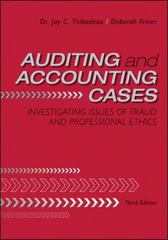Qwest executives allegedly made false and misleading disclosures concerning revenues from its directory services unit, Qwest Dex
Question:
Qwest executives allegedly made false and misleading disclosures concerning revenues from its directory services unit, Qwest Dex Inc. (Dex). In addition, executives were charged with having manipulated revenue from Dex for 2000 and 2001 by secretly altering directory publication dates and the lives of directories.
Dex published telephone directories year-round in approximately 300 markets in 14 states. It earned revenue by selling advertising space in its directories.
Each of its directories typically had a life of 12 months, and Qwest traditionally recognized directory revenue over the life of the directory. However, in late 1999 Dex adopted a “point of publication” method of accounting and began to recognize all advertising revenue for a directory as soon as Dex began deliveries of that directory to the public.
In August 2000 Dex executives allegedly informed Qwest senior management that Dex would be unable to achieve the aggressive 2000 earnings’ targets that management had set for it. As one option for making up for the shortfall, Dex suggested that it could publish Dex’s Colorado Springs directory in December 2000 rather than January 2001 as scheduled, thereby allowing Qwest to recognize revenue from the directory in 2000 rather than 2001.
One Dex executive expressed opposition, citing his concern that such a schedule change would merely reduce 2001 revenue and earnings. He also expressed his view that Qwest probably would be required to disclose the change in the regulatory filings with the SEC. Despite this executive’s opposition, Qwest senior management allegedly instructed Dex to move forward with the proposed change.
By recognizing revenue from the Colorado Springs directory in 2000, Qwest generated \($28\) million in additional revenue and \($18\) million in additional earnings before interest and tax, depreciation, and amortization (EBITDA) for the year. The additional revenue generated in 2000 accounted for about 30 percent of Dex’s 2000 year-over-year revenue increase. It further allowed Dex to show 6.6 percent year-over-year revenue growth versus 4.6 percent if the schedule change had not been made.
In Qwest’s 2000 Form 10-K, Qwest informed investors that Dex’s revenue for 2000 increased by almost \($100\) million. It wrote that the increase was due in part to “an increase in the number of directories published.” At the same time, it failed to inform investors that Dex generated nearly one-third of that amount by publishing the Colorado Springs directory twice in 2000. It also did not inform investors that the schedule change would produce a corresponding decline in Dex revenue for the first quarter of 2001.
For 2001 Qwest senior management established revenue and EBITDA targets for Dex that were higher than what Dex management believed was possible to achieve. In fact, the EBITDA target was allegedly \($80–100\) million greater than the amount Dex management believed was achievable. The SEC found that Dex management complained to Qwest’s senior management about the unrealistic targets. Yet Qwest’s senior management not only allegedly refused to change the targets but also did not allow Dex a reduction in the targets to compensate for the revenue from the Colorado Springs directory that was recognized in 2000. In March 2001 Dex management met with some of Qwest’s senior management to discuss “gap-closing” ideas for the first two quarters of 2001 in an attempt to achieve its 2001 financial targets. One idea was to advance the publication dates of several directories, thus allowing Dex to recognize revenue in earlier quarters; another idea was to lengthen the lives of other directories from 12 to 13 months, thereby allowing Dex to bill each advertiser for one additional month of advertising fees in 2001. Senior managers at Qwest allegedly instructed the Dex managers to implement the changes, as well as other changes to allow it to meet its third- and fourth-quarter financial targets.
During 2001 Dex advanced the publication dates or extended the lives of 34 directories. Those schedule changes produced \($42\) million in additional revenue and \($41\) million in additional EBITDA. Qwest’s Form 10-Qs for the first three quarters of 2001 stated that period-over-period improvements in Dex’s revenue were due in part to changes in the “mix” and/or the “lengths” of directories published. Like the 2000 Form 10-K, these reports did not include any information about the directory schedule changes or the reasons for those changes.
Case Questions
1. Consider the principles, assumptions, and constraints of Generally Accepted Accounting Principles (GAAP). Define the revenue recognition principle and explain why it is important to users of financial statements.
2. Describe specifically why the revenue recognition practices of Dex were not appropriate under GAAP.
3. Do you believe that Qwest had established an effective system of internal control over financial reporting related to the revenue recorded by Dex in its financial statements? Why or why not?
4. Next consider the impact of the pressure exerted by Qwest’s senior management team to meet aggressive revenue and earnings targets. Comment about why such a “tone at the top” would have a pervasive effect on the reliability of financial reporting at a company like Qwest.
5. Consider the role of an upper manager at Dex. Do you believe that a “point of publication” method of accounting is allowable under Generally Accepted Accounting Principles? If so, make an argument that supports the recognition of revenue related to the Colorado Springs directory in December 2000, as opposed to 2001. Do you believe that the actions of the upper managers at Dex were ethical? Why or why not?
Step by Step Answer:

Auditing And Accounting Cases Investigating Issues Of Fraud And Professional Ethics
ISBN: 9780078110818
3rd Edition
Authors: Jay Thibodeau, Deborah Freier





